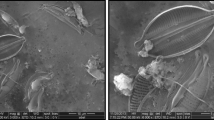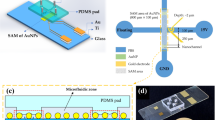Abstract
Diatoms have silica frustules with transparent and delicate micro/nano scale structures, multilevel pore arrays, and large specific surface areas. We explored the potential of diatom frustules as biomolecule support for use in optical detection, for example, in protein or DNA biochips and “lab-on-a-chip” sensors. After the solution was evaporated, most particles in the solution assembled on the frustules. Experiments indicated that this phenomenon occurs because of the large specific surface of the frustules; consequently, we studied the capacity of frustules to increase the density of antibodies. The frustules of diatoms Coscinodiscus sp., Navicula sp., and Nitzschia palea were used in this study. The colored particles for optical detection included standard protein, soybean lecithin, bovine serum albumin, and human immunoglobulin G labeled with fluorescein and carbonic black ink. The results showed that the fluorescein isothiocyanate protein was densely assembled on the frustules and exhibited a fluorescence signal that is 2.5 times stronger than that of glass. Compared with the traditional glass substrate, the frustules significantly improved the antibody density and detection signals. The evaporating assembly method was used for measuring the load capacity of frustules for different antibodies; this method can be used to quantitatively bind two or more antibodies to the frustule, which may be valuable in lab-on-a-chip sensors. The design scheme of high-throughput diatom-based biochips was discussed. Through analysis, we hypothesized that diatom frustules with a large specific surface area, high transparency and pore permeability, small sizes and heights, and flat surfaces are particularly suitable for optical detection of biomolecules.









Similar content being viewed by others
References
Round FE, Crawford RM, Mann DG (1990) The diatoms: biology and morphology of the genera. Cambridge University Press, Cambridge
Bozarth A, Maier U-G, Zauner S (2009) Appl Microbiol Biotechnol 82(2):195
Hamm CE, Merkel R, Springer O, Jurkojc P, Maier C, Prechtel K, Smetacek V (2003) Nature 421(6925):841
Losic D, Short K, Mitchell JG, Lal R, Voelcker NH (2007) Langmuir 23(9):5014
Losic D, Rosengarten G, Mitchell JG, Voelcker NH (2006) J Nanosci Nanotechnol 6(4):982
De Stefano L, Rendina I, De Stefano M, Bismuto A, Maddalena P (2005) Appl Phys Lett 87(23):233902
Bao Z, Weatherspoon MR, Shian S, Cai Y, Graham PD, Allan SM, Ahmad G, Dickerson MB, Church BC, Kang Z, Abernathy Iii HW, Summers CJ, Liu M, Sandhage KH (2007) Nature 446(7132):172
De Stefano L, Rea I, Rendina I, De Stefano M, Moretti L (2007) Opt Express 15(26):18082
Gordon R, Losic D, Tiffany MA, Nagy SS, Sterrenburg FAS (2009) Trends Biotechnol 27(2):116
Jeffryes C, Campbell J, Li H, Jiao J, Rorrer G (2011) Energy Environ Sci 4(10):3930
Losic D, Yu Y, Aw MS, Simovic S, Thierry B, Addai-Mensah J (2010) Chem Commun 46(34):6323
Nassif N, Livage J (2011) Chem Soc Rev 40(2):849
Jafar Ezzati Nazhad D, Miguel DLG (2011) TrAC Trends Anal Chem (Regular ed) 30(9):1538
Losic D, Mitchell JG, Voelcker NH (2009) Adv Mater 21(29):2947
Yang W, Lopez PJ, Rosengarten G (2011) Analyst 136(1):42
Zhang D, Pan J, Cai J, Wang Y, Jiang Y, Jiang X (2012) J Micromech Microeng 22(3):035021
Pan J, Cai J, Zhang D, Wang Y, Jiang Y (2012) Physica E. doi:10.1016/j.physe.2012.1003.1032
De Stefano L, Rotiroti L, De Stefano M, Lamberti A, Lettieri S, Setaro A, Maddalena P (2009) Biosens Bioelectron 24(6):1580
Gale DK, Gutu T, Jiao J, Chang C-H, Rorrer GL (2009) Adv Funct Mater 19(6):926
De Stefano L, Larnberti A, Rotiroti L, De Stefano M (2008) Acta Biomater 4(1):126
Townley HE, Parker AR, White-Cooper H (2008) Adv Funct Mater 18(null):369
Yu Y, Addai-Mensah J, Losic D (2012) Sci Technol Adv Mater 13(1)
Lin K-C, Kunduru V, Bothara M, Rege K, Prasad S, Ramakrishna BL (2010) Biosens Bioelectron 25(10):2336
Umemura K, Noguchi Y, Ichinose T, Hirose Y, Kuroda R, Mayama S (2008) J Biol Phys 34(1–2):189
Wang W, Gutu T, Gale DK, Jiao J, Rorrer GL, Chang C-H (2009) J Am Chem Soc 131(12):4178
Wang Y, Pan J, Cai J, Li A, Chen M, Zhang D (2011) Chem Lett 40(12):1354
Zhang DY, Wang Y, Pan JF, Cai J (2010) J Mater Sci 45(21):5736. doi:10.1007/s10853-010-4642-x
Wang Y, Pan J, Cai J, Zhang D (2012) Biochem Biophys Res Commun 420(1):1
Matovic B, Saponjic A, Devecerski A, Miljkovic M (2007) J Mater Sci 42(14):5448. doi:10.1007/s10853-006-0780-6
Zhang DY, Wang Y, Zhang WQ, Pan JF, Cai J (2011) J Mater Sci 46(17):5665. doi:10.1007/s10853-011-5517-5
Acknowledgements
This study was supported by the National Science Foundation of China (No. 50805005, 51075020), the 863 Project of China (No. 2009AA043804), the National Special Fund of Outstanding Doctoral Dissertation of China (No. 2007B32), and the Doctoral Candidate Academic Newcomer Award of Beihang University.
Conflict of interest
None.
Author information
Authors and Affiliations
Corresponding author
Electronic supplementary material
Below is the link to the electronic supplementary material.
10853_2012_6554_MOESM1_ESM.doc
Supplementary material includes the experimental details of evaporating assembly (observation of protein assembly, control experiment using living cells of diatom Coscinodiscus sp., and control experiment using carbonyl iron coated diatomite), images of diatom substrates used in experiments, scanning data of the partially arrayed diatom substrate, and SEM images of Nitzschia frustules. This material is available free of charge via Internet. (DOC 14796 kb)
Rights and permissions
About this article
Cite this article
Wang, Y., Zhang, D., Pan, J. et al. Key factors influencing the optical detection of biomolecules by their evaporative assembly on diatom frustules. J Mater Sci 47, 6315–6325 (2012). https://doi.org/10.1007/s10853-012-6554-4
Received:
Accepted:
Published:
Issue Date:
DOI: https://doi.org/10.1007/s10853-012-6554-4




